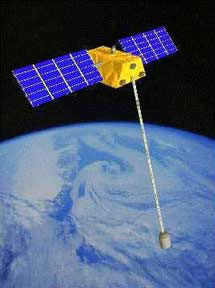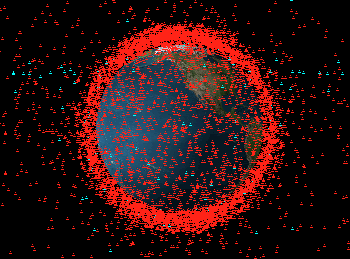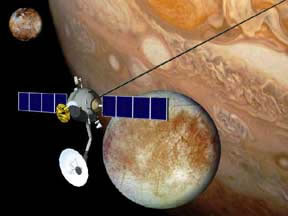Science Fiction
Dictionary
A B C D E F G H I J K L M N O P Q R S T U V W X Y Z
Electrodynamic Tethers: Clean Up Debris - Power or Boost Spacecraft

An electrodynamic tether (EDT) is a simple idea, but one with an amazing number of uses. An EDT system is made up of two masses in orbit connected by a long, flexible, electrically conductive cable; the tether is essentially a wire that moves through the magnetic field of the Earth (or another planet or large body). An EDT takes advantage of two basic principles of electromagnetism: current is produced when a conductive wire moves through a magnetic field, and the field exerts a force on the current. While it is not a colorful as the Rasta space tug from William Gibson's Neuromancer, it could provide a technology that takes low-flying satellites to a new level.

(From NASA Tethered Spacecraft)
An EDT can use these principles in two ways:
- An EDT can generate electric current flow towards the planet; this can provide enough electricity to run experiments on board a satellite; this also causes the tether to experience a force from the planet's magnetic field that is opposite the tether's direction of motion. In other words, it slows the EDT system down (produces drag), lowering the EDT's orbit.
- By adding a battery (or solar panel) to the EDT circuit, the induced current is overcome, reversing the current direction; the force experienced by the tether is now in the same direction as the EDT's motion. In other words, this produces thrust, raising its orbital attitude.
As discussed, this method of creating electrical power has a serious side-effect, namely, that the spacecraft or satellite will experience drag. That is, it will slow down and seek a lower orbit, eventually crashing on the planet. However, there is a way to turn this "bug" into a feature. One problem that is getting worse around Earth is that of discarded "space junk" (see illustration below). This property of EDTs could be used to bring down this junk earlier and in a controlled fashion. At the end of a satellite's life (or a rocket stage, or anything else), it is given a signal to release a long wire antenna. A current will flow in the wire, and the satellite will begin to slow down, quickly heading for burn-up in the atmosphere.

(From Center for Orbital and Reentry Debris Study)
The second use of EDT is really amazing. The International Space Station will require over seventy tons of propellant over the next ten years to keep its orbit from decaying. All of this reaction mass must be hauled up the gravity well at a cost of $7,000 per pound (not $7, as previously stated)! A properly deployed EDT, combined with another power source, could actually push itself forward on the Earth's magnetic field, speeding the IST up without the use of any propellant.
This will have profound implications on missions to other planets, since satellite missions will no longer need to carry expendable propellant to continue their missions. An EDT can be used to alternately boost to a new location, and then reverse current and use the resulting drag force to decellerate and fine-tune its orbit. This greatly extends the useful life of these space probes.

(From NASA Tethered Spacecraft)
So why aren't EDTs in widespread use? The biggest problems are electromechanical; EDTs experience high voltages in space. Also, EDTs are prone to vibrations that produce significant mechanical forces. Also, development has been slow; a program planned for launch in 2004, ProSEDs, was repeatedly postponed and ultimately canceled.
Science fiction author David Brin has made a good story (from 1982) available; you might want to go read Tank Farm Dynamo. This story is a poignant tale of what might have been in the last century of American space travel. The story takes maybe fifteen minutes to read - it's well worth it! For another spacetug story, see ConeXpress OLEV - Will A Good Tug Save Hubble?.
A lot of the background information for this article was found in Electrodynamic Tethers in Space from the August issue of Scientific American; unfortunately, it's not free. Thanks to yet another alert reader for the scoop on this story.
Long space tethers don't need to be conductive to have unusual effects - take a look at Non-Conductive Tethers - Free Artificial Gravity In Orbit.
Scroll down for more stories in the same category. (Story submitted 11/5/2004)
Follow this kind of news @Technovelgy.| Email | RSS | Blog It | Stumble | del.icio.us | Digg | Reddit |
Would
you like to contribute a story tip?
It's easy:
Get the URL of the story, and the related sf author, and add
it here.
Comment/Join discussion ( 6 )
Related News Stories - (" Space Tech ")
Will Space Stations Have Large Interior Spaces Again?
'They filed clumsily into the battleroom, like children in a swimming pool for the first time, clinging to the handholds along the side.' - Orson Scott Card, 1985.
Reflect Orbital Offers 'Sunlight on Demand' And Light Pollution
'I don't have to tell you about the seven two-mile-diameter orbital mirrors...'
Chrysalis Generation Ship to Alpha Centauri
'This was their world, their planet —
this swift-traveling, yet seemingly moveless vessel.' - Nat Schachner, 1934
The First Space Warship For Space Force
'Each of the electrical ships carried about twenty men...' - Garrett P. Serviss, 1898.
Technovelgy (that's tech-novel-gee!) is devoted to the creative science inventions and ideas of sf authors. Look for the Invention Category that interests you, the Glossary, the Invention Timeline, or see what's New.
Science Fiction
Timeline
1600-1899
1900-1939
1940's 1950's
1960's 1970's
1980's 1990's
2000's 2010's
Current News
The Zapata Air Scooter Would Be Great In A Science Fiction Story
'Betty's slapdash style.'
Thermostabilized Wet Meat Product (NASA Prototype)
There are no orbiting Michelin stars. Yet.
Could Crystal Batteries Generate Power For Centuries?
'Power could be compressed thus into an inch-square cube of what looked like blue-white ice'
India Ponders Always-On Smartphone Location Tracking
'It is necessary... for your own protection.'
Amazon Will Send You Heinlein's Knockdown Cabin
'It's so light that you can set it up in five minutes by yourself...'
Is It Time To Forbid Human Driving?
'Heavy penalties... were to be applied to any one found driving manually-controlled machines.'
Replace The Smartphone With A Connected Edge Node For AI Inference
'Buy a Little Dingbat... electropen, wrist watch, pocketphone, pocket radio, billfold ... all in one.'
Artificial Skin For Robots Is Coming Right Along
'... an elastic, tinted material that had all the feel and appearance of human flesh and epidermis.'
Robot Guard Dog On Duty
I might also be thinking of K-9 from Doctor Who.
Wearable Artificial Fabric Muscles
'It is remarkable that the long leverages of their machines are in most cases actuated by a sort of sham musculature...'
BrainBridge Concept Transplant Of Human Head Proposed
'Briquet’s head seemed to think that to find and attach a new body to her head was as easy as to fit and sew a new dress.'
Google's Nano Banana Pro Presents Handwritten Math Solutions
'...copy was turned out in a charming and entirely feminine handwriting.'
Edible Meat-Like Fungus Like Barbara Hambly's Slunch?
'It was almost unheard of for slunch to spread that fast...'
Sunday Robotics 'Memo' Bot Has Unique Training Glove
'He then started hand movements of definite pattern...'
Woman Marries Computer, Vonnegut's Dream Comes True
'Men are made of protoplasm... Lasts forever.'
Natural Gait With Prosthetic Connected To Nervous System
'The leg was to function, in a way, as a servo-mechanism operated by Larry’s brain...'
